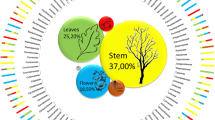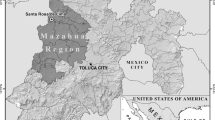Botanical Provenance of Historical Chinese Dye Plants. Dye plants are an essential part of historical dyeing activities for textiles. Their correct botanical provenance is an important basis for understanding the sources mentioned in dyeing instructions and for chemical identification of the dyes on the textiles themselves. This paper describes a combined study of dyeing recipes in four historical manuscripts of the Ming (1368–1644 C.E.) and Qing Dynasties (1644–1911 C.E.). Within the context of historical plant medicine and botanical classification, this study resolves uncertainties about the names, provenance, and preferences for the significant dyes in Chinese textile history for the first time, namely safflower, sappanwood, smoketree, pagoda bud, Amur cork tree, indigo, Chinese gallnut, acorn cup, dark plum, munjeet, gromwell, gardenia, and turmeric. Most dye plants in the historical manuscripts refer to one or two major species or variants, with ambiguity arising mainly from non-uniform naming conventions and conversion between different taxonomies. It is now clear that saffron was confused with safflower in Ming Dynasty herbal plants instructions, that Su mu 蘇木 meant sappanwood (Caesalpinia sappan L.), and occasionally foreign redwoods from genera Caesalpinia and Haematoxylum, and that huang lu mu 黃櫨木, huang lu黃蘆 and lu mu 蘆/櫨木 were all variants of Cotinus coggygria Scop. Pagoda bud can be identified by huai hua 槐花, huai mi 槐米, huai hua mi 槐花米, and huai zi 槐子, while jiang huang 薑黃 and yv jin 郁金, recorded for dyeing, both referred to the rhizome of Curcuma longa L. Of the various zhi zi 梔子 available, zhi zi for dyeing was Gardenia jasminoindes Ellis f. longicarpa Z·W·Xie et M. Okada, although whether this preference was widely recognized or practiced is not clear. This research promotes a better understanding of historical Chinese dye plants. It also complements existing research results of historical herbal medicine in the aspect of dyeing.
古代中国染料植物的原植物考证。染料植物是古代纺织品染色活动的重要内容,对古代染料植物正确的原植物鉴别是染色历史文献研究和文物染料化学鉴定的重要基础。本文针对四篇明清时期历史文献中的染色工艺记载做了跨学科研究,首次集中探讨了中国纺织史中重要染料植物的名称、原植物和使用偏好。这些染料包括红花、苏木、黄栌、槐花、黄檗、靛蓝、五倍子、皂斗、乌梅、茜草、紫草、栀子和姜黄。研究发现,历史文献中的染料植物多指一或两个种或是变体。染料原植物的不确定性的主要原因是缺少统一的命名规则和不同分类学体系之间的转换。进一步研究表明,红花和番红花是两种不同的染料植物。苏木指云实科植物苏木 Caesalpinia sappan L.,偶尔也指云实属和墨水树属的外国红木。染色历史文献中的黄栌木、黄芦和芦/栌木均指漆树科植物黄栌Cotinus coggygria Scop.的几个变种。槐花、槐米、槐花米和槐子这些名称均指槐花的花蕾。历史文献中用于染色的姜黄和郁金都指姜科植物姜黄 Curcuma longa L.的根茎。不同的栀子用途有别,用于染色的栀子主要是茜草科植物长果栀子Gardenia jasminoindes Ellis f. longicarpa Z·W·Xie et M. Okada,但这种偏好在古代是否被广泛认可和实践还不清楚。本研究推进了对中国古代染料植物的正确理解,并对已有的本草学考证成果在染色方面进行了补充。
Similar content being viewed by others
Literature Cited
Bu, R. 2004. Herbal medicine research of the Mongolian medicine gardenia. Journal of Chinese Medicinal Materials 27:692–694.
Cardon, D. 2007. Natural dyes: Sources, tradition, technology and science. Archetype, London.
CASFRPSE (Chinese Academy of Sciences “Flora Republicae Popularis Sinicae” Editorial). 1959–2004. Flora Republicae Popularis Sinicae. http://frps.eflora.cn/. Beijing: Kexue chubanshe.
Chen, S., R. Feng, B. Chen, L. Jing, X. Dong, Z. Gu, and S. Wang. 1991. A study on the medicinal plants of genus Rubia. I. Botanical origins and resource of chinese traditional drug “qiancao” (munjeet). Natural Product Research and Development 3:7–15.
———, T. Liu, and K. Liu. 2001. Huangbai [Amur cork tree]. Zhongguo zhongyiyao chubanshe, Beijing.
Chen, W. 1984. Zhongguo fangzhi kexue jishushi. Gudai bufen. [History of the science and technology of Chinese textile. The ancient part]. Kexue chubanshe, Beijing.
Chen, Y. 1735. Gezhi jingyuan [Mirror origins of investigating things and extending knowledge], Vol. 65. Peking University Library collection, Beijing.
Geissman, T. and L. Jurd. 1954. Anthochlor pigments. IX. The structure of the aurone pigment of Cosmos sulfureus, “Orange Flare” and “Yellow Flare.”. Journal of the American Chemical Society 76:4475–4476.
GJZYYGLJ (Guojia zhongyiyao guanliju zhonghua bencao bianweihui [National Bureau of Traditional Chinese medicine, Chinese Materia Medica Editorial Board]). 1999. Zhonghua bencao [Chinese Materia Medica]. Shanghai kexue jishu chubanshe, Shanghai.
Gu, T. 1995. Daming huidian [Collected statutes of the Ming Dynasty]. Pages 541–542 in S. Xuxiu, ed., The Sequel to the Annotated Bibliography of the Four Treasures. Shanghai guji chubanshe, Shanghai.
Gu, Y. 2011. Tianxia junguo libing shu [The characteristics of each province in the empire]. Page 3934 in Huadongshifandaxue gujisuo, ed., Gu Yanwu Quanji [the Complete Works of Gu Yanwu]. Shanghai guji chubanshe, Shanghai.
Guojia yaodian weiyuanhui [National Committee of Pharmacopoeia]. 2010. Zhonghua renmin gongheguo yao dian [Pharmacopoeia of the People’s Republic of China]. Zhongguo yiyao keji chubanshe, Beijing.
Han, J. and A. Quye. 2014. Dyeing practice and the society: A study of historical Chinese dyes of the Ming and Qing dynasties (1368–1911) by chemical analysis and history of art. Dyes in History and Archaeology 33:14.
Hao, X., N. Li, and S. Wang. 2000. Herbal research on turmeric. Journal of Hebei Traditional Chinese Medicine and Pharmacology 15:29–30.
Laufer, B. 1919. Sino-Iranica: Chinese contributions to the history of civilization in ancient Iran: With special reference to the history of cultivated plants and products. Field Museum of Natural History, Chicago.
Li, S. 1884. Xvzuan Chun’an xianzhi [The sequel to the records of Chun’an]. Peking University Library collection, Beijing.
Li, S. 1975. Bencao gangmu: Jiaodianben [Compendium of materia medica; revised and punctuated]. Renmin weisheng chubanshe, Beijing.
Lin, R., J. Zhang, and J. Zheng. 2011. Zhongguo yaocai biaozhun minglu [Standard Directory of Chinese Herbs]. Kexue chubanshe, Beijing.
Liu, J. 1995. Duoneng bishi [Various arts in everyday life]. In: Xuxiu Siku quanshu bianzuan weiyuanhui [Editorial Committee of Catalogue Series of the Annotated Bibliography of the Four Treasures], ed. Xuxiu Siku quanshu [Catalogue Series of the Annotated Bibliography of the Four Treasures], 49–50. Shanghai: Shanghai guji chubanshe.
Mouri, C. and R. Laursen. 2012. Identification of anthraquinone markers for distinguishing Rubia species in madder-dyed textiles by HPLC. Microchimica Acta 179:105–113.
Neiwufu. Qing Dynasty. Neiwufu quanzong dang’an, zhiranju buce [Complete File of the Imperial Household, Volume of the Weaving and Dyeing Bureau]. Beijing: The First Historical Archives of China collection.
Nowik, W. 2001. The possibility of differentiation and identification of red and blue “soluble” dyewoods: Determination of species used in dyeing and chemistry of their dyestuffs. Dyes in History and Archaeology 16(17):129–144.
NUTCM (Nanjing University of Traditional Chinese Medicine). 2006. Zhongyao dacidian [Dictionary of Chinese medicine], 2nd edition. Shanghai kexue jishu chubanshe, Shanghai.
Peggie, D. A., A. N. Hulme, H. McNab, and A. Quye. 2008. Towards the identification of characteristic minor components from textiles dyed with weld (Reseda luteola L.) and those dyed with Mexican cochineal (Dactylopius coccus Costa). Microchimica Acta 162:371–380.
Peng, Z. 1997. Hongzhi Huizhou fuzhi [Records of Huizhou in Hongzhi period]. In: Siku quanshu cunmu congshu·Shibu [Catalogue Series of the Annotated Bibliography of the Four Treasures·History], 679. Jinan: Qilu shushe.
Qi, Z. and C. Li. 2012. Name correction for traditional herbs of “huangbo” and “huanglu.”. Hebei Journal of Forestry and Orchard Research 27:189–193.
Qian, X. 2005. Zhongguo chuantong gongyi quanji·Sichou zhiran [Complete works of Chinese traditional craft·Silk weaving and dyeing]. Daxiang chubanshe, Zhengzhou.
Qu, D. 1995. Guangdong xinyu [A new account on Guangdong]. In: XuxiuSikuquanshuBianweihui [Editorial Committee of The Sequel to the Annotated Bibliography of the Four Treasures], ed. Xuxiu Sikuquanshu [The Sequel to the Annotated Bibliography of the Four Treasures], 676–678. Shanghai: Shanghai guji chubanshe.
Quye, A., H. Cheape, J. Burnett, E. S. Ferreira, A. N. Hulme, and H. McNab. 2000. An historical and analytical study of red, pink, green and yellow colors in quality 18th-and early 19th-century Scottish tartans. Dyes in History and Archaeology 19:1–12.
Ricci, M. 1935. Matteo Ricci’s world-map in Chinese, 1602. Beijing yvgong xuehui, Beijing.
Sampathu, S., S. Shivashankar, Y. Lewis, and A. Wood. 1984. Saffron (Crocus sativus Linn.)—Cultivation, processing, chemistry and standardization. Critical Reviews in Food Science and Nutrition 20:123–157.
Shu, Y. 1992. Ancient gardenia and its cultivation and utilization. Agricultural History of China 12:78–84.
Song, Y. and J. Pan, eds. 1992. Tiangong kaiwu yizhu [Chinese Technology in the Seventeenth Century, translated and annotated]. Shanghai guji chubanshe, Shanghai.
Su, S. and Z. Shang, eds. 1994. Bencao tujing [Illustrated Classic of the Materia Medica]. Anhui kexue jishu chubanshe, Hefei.
Unknown. Qing Dynasty. Bu jing [The Cloth Classic]. Hefei: Anhui Library collection.
Unknown. Yuan Dynasty, republished in 1988. Jujia biyong shilei quanji: Quan shi juan [Guide to domestic operations: 10 volumes]. In: Beijing tushuguan guji zhenben congkan 61 [Rare historic books collections of Beijing Library, Vol. 61], ed. Beijing tushuguan guji chuban bianjizu, 286–288. Beijing: Shumu wenxian chubanshe.
Wang, Q. 1986. Huaihua yv huaimi bingcun zhide shangque [The coexistence of huaihua and huaimi is debatable]. Information on Traditional Chinese Medicine 4:45.
Wang, Y., J. Liu, and Y. Tong. 2011. Qingdai zhiranju ranse fangfa ji secai [Dyeing methods and colors in the Weaving and Dyeing Bureau of the Qing Dynasty]. Historical Archives 31:125–127.
Wang, Z., Y. Chen, and Y. Chen. 2001. Honghua [Safflower]. Zhongguo zhongyiyao chubanshe, Beijing.
Wu, D. and C. Li. 2008. Textual research on Arnebia. Lishizhen Medicine and Materia Medica Research 19:2042–2043.
Wu, Q. 1963. Zhiwu mingshi tukao [Illustrated investigation of the names and natures of plants]. Zhonghua shuju, Beijing.
Wu, S. 1912–1949. Republic of China. Ran jing [The Dyeing Classic]. Zhongguo fangzhi kejishi ziliao.
Xiao, P., D. Li, and S. Yang. 2002. Xin bian Zhong yao zhi [Modern Chinese materia medica]. Huaxue gongye chubanshe, Beijing.
Xie, Z. 1984. Ideas and methods of herbal medicine research on Chinese herbal medicines. Zhong yao cai ke ji [Journal of Chinese Medicinal Materials] 7(3):37–39, 7(5):36–38, 7(6):37–39.
———. 1991a. Discussion on the variety and quality evaluation of water gardenia (shui zhizi). Journal of Chinese Medicinal Materials 14:45–47.
———. 1991b. Zhongyao pinzhong lilun yanjiu [Theoretical studies in Chinese medicine varieties]. Beijing: Zhongguo zhongyiyao chubanshe: Xinhua shudian keji faxingsuo faxing.
Zhang, G. 2007. Ethnobotanical studies on dyeing plants used in Xishuangbanna, Yunnan, China, Laboratory of Ethnobotany, Kunming Institute of Botany, Chinese Academy of Sciences, Kunming.
Zhang, Z., S. Pei, and B. Li. 2003. The use of ethnobotany methods in the research of ethnic folk dyeing plants. Acta Botanica Yunnanica 115:115–122.
Zhang, G., S. Pei, B. Li, and Y. Pu. 2004. A study on edible pigment-plant resources in Xishuangbanna, Yunnan Province of China. Acta Botanica Yunnanica Suppl 15:61–69.
Zhang, L. and L. Zeng. 2006. Performance of four natural dyes on wool. Wool Textile Journal 34:17–22.
Zhang, X., D. Cardon, J. L. Cabrera, and R. Laursen. 2010. The role of glycosides in the light-stabilization of 3-hydroxyflavone (flavonol) dyes as revealed by HPLC. Microchimica Acta 169:327–334.
Zhao, F. 1987. Honghua zai gudai zhongguo de chuanbo, zaipei he yingyong [The spread, cultivation and application of safflower in ancient China]. China Agricultural History 7:61–71.
——— 1997. Zhiwu ranliao zai gudai zhongguo de yingyong [The application of plant dyes in ancient China]. Pages 209–248 in X. Zhu, ed., Zhongguo sichoushi. Zhuanlun [History of Chinese silk. Monograph]. Zhongguo fangzhi chubanshe, Beijing.
Zhao, H. 1999. A preliminary discussion on the history and technology of Symplocos Caudata in Song Dynasty. Studies in the History of Natural Sciences 42:87–94.
Acknowledgments
The author acknowledges financial support from the Textile Conservation Foundation, the Swire Charitable Trust, and the Sym Charitable Trust. I would like to thank Dr. Guo Baolin (Institute of Medicinal Plant Development) for generously sharing the knowledge and research methods of botany. I also gratefully appreciate strong support and important comments for the preparation and revision of this article from my research supervisors Dr. Anita Quye (University of Glasgow), Professor Nick Pearce (University of Glasgow), and Dr. Yupin Chung (Glasgow Museums). Efforts by Miss Sun Xuejing (Peking University) to check historical Chinese records are acknowledged as well.
Author information
Authors and Affiliations
Corresponding author
Rights and permissions
About this article
Cite this article
Han, J. Botanical Provenance of Historical Chinese Dye Plants. Econ Bot 69, 230–239 (2015). https://doi.org/10.1007/s12231-015-9314-y
Received:
Accepted:
Published:
Issue Date:
DOI: https://doi.org/10.1007/s12231-015-9314-y




